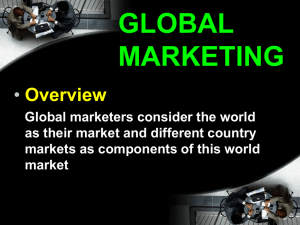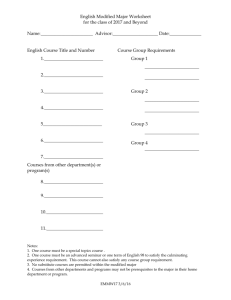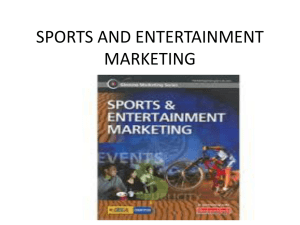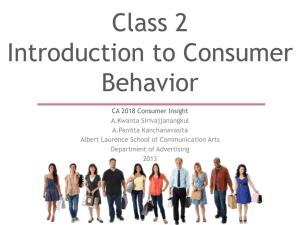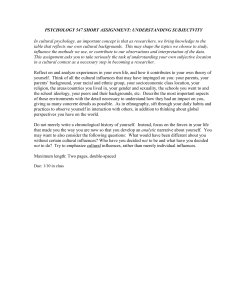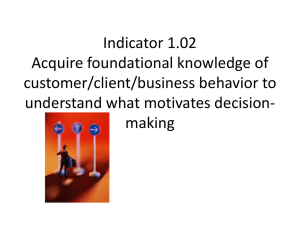Chapter 1 The Fields of Marketing
advertisement
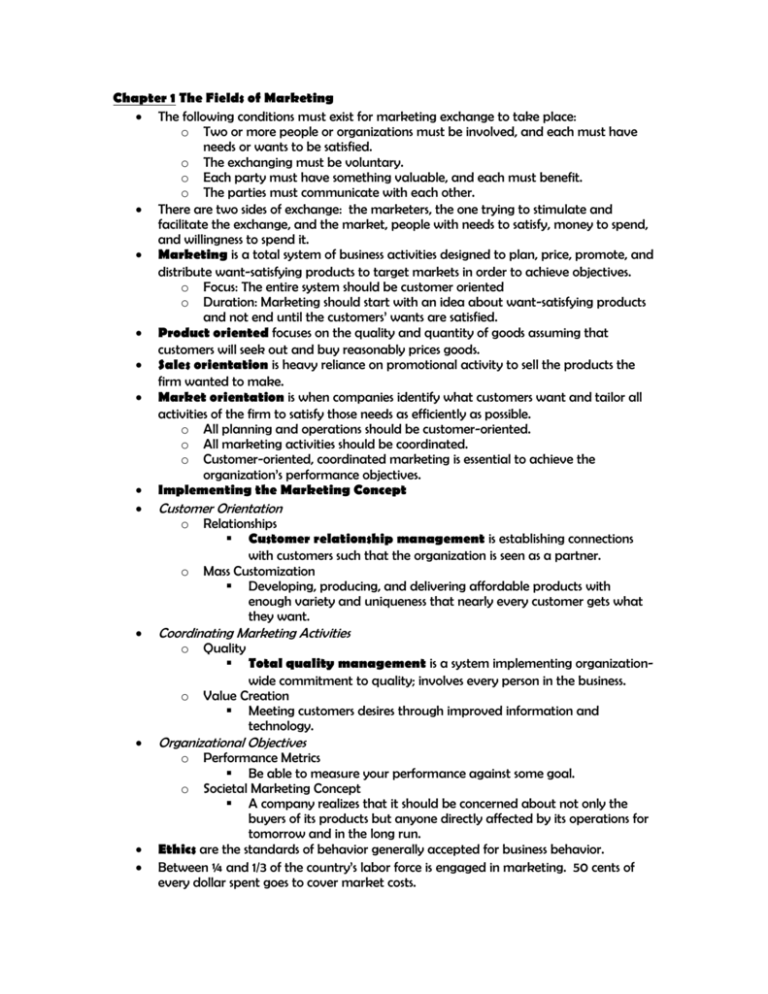
Chapter 1 The Fields of Marketing The following conditions must exist for marketing exchange to take place: o Two or more people or organizations must be involved, and each must have needs or wants to be satisfied. o The exchanging must be voluntary. o Each party must have something valuable, and each must benefit. o The parties must communicate with each other. There are two sides of exchange: the marketers, the one trying to stimulate and facilitate the exchange, and the market, people with needs to satisfy, money to spend, and willingness to spend it. Marketing is a total system of business activities designed to plan, price, promote, and distribute want-satisfying products to target markets in order to achieve objectives. o Focus: The entire system should be customer oriented o Duration: Marketing should start with an idea about want-satisfying products and not end until the customers’ wants are satisfied. Product oriented focuses on the quality and quantity of goods assuming that customers will seek out and buy reasonably prices goods. Sales orientation is heavy reliance on promotional activity to sell the products the firm wanted to make. Market orientation is when companies identify what customers want and tailor all activities of the firm to satisfy those needs as efficiently as possible. o All planning and operations should be customer-oriented. o All marketing activities should be coordinated. o Customer-oriented, coordinated marketing is essential to achieve the organization’s performance objectives. Implementing the Marketing Concept Customer Orientation o Relationships Customer relationship management is establishing connections with customers such that the organization is seen as a partner. o Mass Customization Developing, producing, and delivering affordable products with enough variety and uniqueness that nearly every customer gets what they want. Coordinating Marketing Activities o Quality Total quality management is a system implementing organizationwide commitment to quality; involves every person in the business. o Value Creation Meeting customers desires through improved information and technology. Organizational Objectives o Performance Metrics Be able to measure your performance against some goal. o Societal Marketing Concept A company realizes that it should be concerned about not only the buyers of its products but anyone directly affected by its operations for tomorrow and in the long run. Ethics are the standards of behavior generally accepted for business behavior. Between ¼ and 1/3 of the country’s labor force is engaged in marketing. 50 cents of every dollar spent goes to cover market costs. Kinds of Utility: o Form – physical and chemical changes that make a product more valuable. o Place – exists when a product is readily accessible to potential customers. o Time – having a product available when you want it. o Informational – informing prospective buyers that a product exists. o Possession – created when customers buy the product. Chapter 2 The Dynamic Marketing Environments Environmental monitoring is the process of gathering information regarding the company’s external environment, analyzing it, and forecasting the impact of whatever trends the analysis suggests. Two levels of external forces: o Macro influences (affect all firms) such as demographics, economic conditions, culture, and laws. o Micro influences (affect a particular firm) consist of suppliers, marketing intermediaries, and customers. Closely related to the firm. External Microenvironment o A change in any one of the conditions can cause change in one or more of the others… demographics, economic conditions, competition, social and cultural forces, political and legal forces, and technology. Demographics refer to the characteristics of populations, including such factors as size, distribution, and growth. Economic Conditions o Business Cycle goes through 4 stages – prosperity, recession, depression, and recovery – then returns full cycle to prosperity. o Inflation is represented by a rise in the prices of goods and services. o Interest rates – when interest rates are high consumers tend not to make long-term purchases (ex. Housing) Competition o Brand competition comes from marketers of directly similar products. o Substitute products are products that satisfy the same need. o Every company is a rival for the customer’s limited buying power. Social and Cultural Forces o Concern about the natural environment o Changing gender roles (i.e. women having bigger roles in society) o A premium on time; people value their time much more because on average they are putting more time at the office o Physical Fitness and Health; increase in the interest of health today Political and Legal Forces o Monetary and fiscal policies o Social legislation and regulations (ex. Anti-pollution laws) o Governmental relationships with industries (ex. Public utilities) o Legislation related specifically to marketing (know something about law) Technology breakthroughs can affect markets in 3 ways: o Starting entirely new industries o Radically altering, or virtually destroying existing industries. o Stimulating markets and industries not related to the new technology. Market is categorized as people or organizations with needs to satisfy, money to spend, and the willingness to spend it. Marketing intermediaries are organizations that directly aid in the flow of goods and services… Two types: middlemen (ex. Wholesalers and retailers) and facilitating organizations (ex. Transportation, warehousing, and financial services) An organization’s marketing effort is also shaped by internal forces that are controllable by management: production, financial, and personnel activities. Chapter 20 Strategic Marketing Planning The management process, as applied by marketing, consists basically of planning a marketing program, implementing it, and evaluating its performance. o Planning – analyze the situation, set goals, and select strategies and tactics. o Implementation – organize, staff, and direct. o Evaluation – Compare performance goals. Strategic planning is when managers match an organization’s resources with its market opportunities over the long run. Strategic window is the limited amount of time in which a firm’s resources coincide with a particular market opportunity. Essential Planning Concepts o Mission is something stated by the company stating what customers it serves, what needs it satisfies, and what types of products it offers. o Objectives = Goals are simply a desired outcome and should be: clear and specific, stated in writing, ambitious but realistic, consistent with one another, quantitatively measurable when possible, and have a time period. o Strategy is a broad plan of action by which an organization intends to reach its objectives and, in turn, fulfill its mission. o Tactic is a means by which a strategy is implemented. Planning a firm’s marketing strategies should be conducted on 3 different levels: o Strategic company planning – management defines an organization’s mission, sets long-range goals, and formulates broad strategies to achieve the goals. 1. Define the organizational mission 2. Analyze the situation 3. Set organizational objectives 4. Select strategies to achieve these objectives o Strategic marketing planning – top marketing execs set goals and strategies for an organization’s marketing effort. 1. Conduct a situation analysis 2. Develop marketing objectives 3. Determine positioning and differential advantage 4. Select target markets and measure market demand 5. Design a strategic marketing mix o Annual marketing planning – covers a time period of one year; a plan is based on the firm’s strategic marketing planning. Situational analysis involved analyzing where the company’s marketing program had been, how it’s been doing, and what it’s likely to face in years ahead. Positioning refers to a product’s image in relation to competing products as well as other products marketed by the same company. Differential advantage refers to any feature of an organization/brand that customers find desirable and different from the competition. Market consists of people with needs to satisfy, money to spend, and willingness to spend it. Marketing mix is the combination of multiple aspects of a product, how it’s distributed and promoted, and its price. Chapter 4 Consumers Markets and Buying Behavior Ultimate consumers buy goods and services for their own personal or household use. The Urban Population – nearly 75% of the US population lives in large urban areas. Metropolitan statistical area is the basic urban unit; urban area with at least 50,000 people in it. o Micropolitan statistical area must have at least one urban cluster between 10,000 and 50,000 people. o Combined statistical area consists of an adjacent metropolitan and micropolitan statistical area. Demographics are the vital stats that describe a populations o Age o Family Life cycle o Education and income o Race and ethnicity o Stages of the consumer buying-decision process o Need recognition o Identification of alternatives o Evaluation of alternatives o Decisions – to buy or not to buy o Purchase behavior – consumer seeks reassurance that they made a good buy Loyalty exists when a consumer, because of past experience, is satisfied with a particular brand/product so they buy that product without considering other alternatives. Patronage buying motives are reasons why people buy from certain places o Examples: location convenience, service speed, crowding, price, store appearance, sales personnel, merchandise assortment Information and Purchase Decisions o o Social influences o o o o o o Commercial information environment consists of all marketing organizations and individuals that attempt to communicate with consumers. Social information environment is comprised of family, friends, and acquaintances that directly or indirectly provide information about products. Culture: Time has become as valuable as money. Two-income families are the norm. Gender roles are losing their identity. Youthfulness is admired. Subcultures are groups in a culture that exhibit characteristic behavior to distinguish them from other groups within the same culture. Social Class is a ranking within society determined by members of society. Upper class – 2% of population Upper-middle class – 12% of population Lower-middle class – 32% of population Upper-lower class – 38% of population Lower-lower class – 16% of population Reference groups are groups of people who influence a person’s attitudes, values, and behaviors. Family is a group of 2 or more people related by blood, marriage, or adoption. Household consists of a single person, family, or any group sharing a house. Psychological Factors o Motivation – a motive is a need sufficiently stimulated to move an individual to seek satisfaction. o Maslow’s needs hierarchy (p. 101) o o o o Perception is the process of receiving, organizing, and assigning meaning to information or stimuli detected by our 5 senses. Learning involves changes in behavior resulting from observation and experience. Personality is an individual’s pattern of traits that influences behavioral responses Attitude is learned predisposition to respond to an object or class of objects in a consistently favorable or unfavorable way. Attitudes are learned, have an object, have direction and intensity, and tend to be stable and generalizable. Situational Influences o o o o The time dimension The surroundings Terms of purchase Consumer moods and motives
